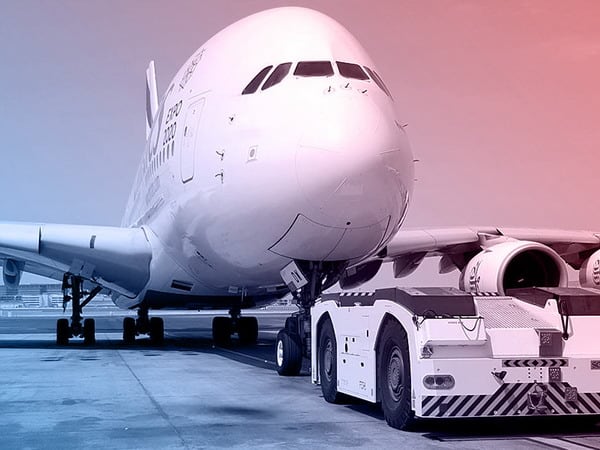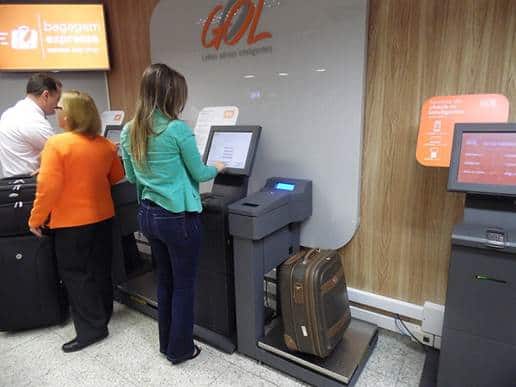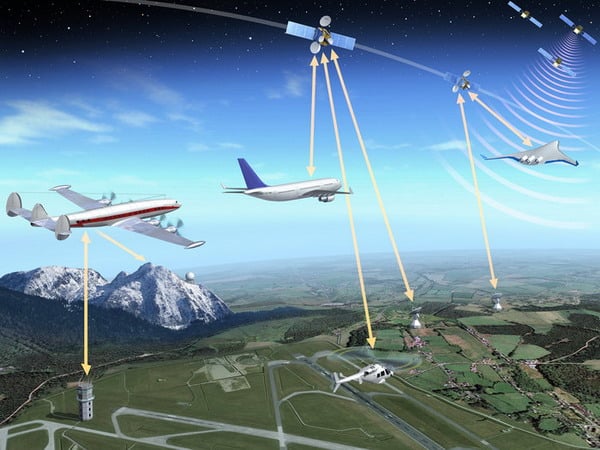Company SITA introduced 10 futuristic predictions related to the passenger experience for future airport technology trends in December 2019. They are based on research results, aircraft industry drivers and innovation.
Future Airports: 10 futuristic predictions for next decade
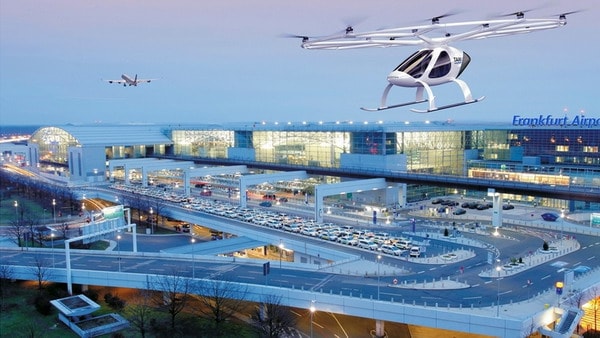
Over the past 10 years, the process of passenger service at airports has changed dramatically thanks to the introduction of biometric screening systems, as well as mobile check-in and baggage tracking services. According to SITA forecasts, accelerated pace of development is expected in the next decade. With the advent of digital transformation in the airline industry, passengers and employees will discover the unlimited possibilities of advanced technologies – from taxi flights to airports with their own intelligent system. SITA claims that major changes will affect almost all airport systems.
According to the International Air Transport Association (IATA), the number of passengers should double in the next twenty years, but the process of expanding airports will not be as quick. And passengers quite rightly want all the processes inside the airport to be carried out without any problems. The only way to ensure uninterrupted operation of air harbors is to develop and apply new technological solutions that increase their efficiency and the quality of passenger service.
Safety will be integrated into a seamless travel system
According to the SITA forecast, over the next decade, passing the control zone will turn into a walk along the corridor. You will no longer need to take off your coat, shoes and belt, put small bottles in small bags. Queues will also be a thing of the past. The recognition system for passengers and their baggage will be triggered automatically when passing through advanced checkpoints. Smart control zones will be replaced by “smart” sensory corridors, which will make checking paper documents obsolete.
Passengers will be able to control the process of digital identification
The introduction of a digital identity card and an individual ID code will allow passengers to independently determine which aspects of their identity should be disclosed during the trip and for what purpose. At airports of the future, the risks of data leakage will be constantly assessed by artificial intelligence (AI) specialists using digital passenger identification. The most important elements of this data will only be provided to governments of countries that use automated systems to approve – or, in some cases, disapprove – the various phases of an air travel. Moreover, airlines will no longer be responsible for the processing of passenger data in order to ensure the safety of state borders, according to SITA.
The journey itself will be decentralized
Each category will have its own tags: for passengers, baggage or cargo. All this will be monitored throughout the trip, regardless of the mode of transport used. This means that it will be possible to obtain a travel permit and pass customs checks before arrival at the airport, which will save a lot of time. At the same time, the service of remote baggage drop-off will be offered where it is most convenient for the passenger, for example, at stations.
The airport will be equipped with high-speed communications

According to SITA experts, in the era of connected airports, cheaper sensors, less specialized equipment and new cloud data services running on devices over 5G will be used. Data will be collected through software-defined networks, then the information will go through the stage of comparison and analysis. This method will increase the efficiency of the airport and help make it much more convenient for passengers.
The airport will “think” on its own
Experts predict that the algorithms of artificial intelligence (AI) will be the key to efficiency and sophisticated AI will be the secret of the success of the airline industry. Air harbors will use Digital Twin technology to work in real time with all interested parties, streamlining operations and improving the quality of passenger service.
In general, Digital Twin is an advanced computer simulation that uses data from the entire airport and airlines for further interaction and forecasting. This data is then applied to optimize operations and maximize automation. Thus, you can send voice messages to employees of various services – from immigration to cleaning. As a result, you can get proactive answers and, therefore, more prompt and accurately planned actions by airlines and airports.
Collaboration will be crucial
For the safety and comfort of each trip is responsible from 10 or more different organizations. The only way to collect all the data and make the trip “seamless” is to ensure close cooperation between all agencies: the airport, airlines, government agencies, ground services, restaurants and shops. Uninterrupted operation of all components of the airborne ecosystem is also required.
Within this ecosystem, operational data will be transmitted using trust mechanisms, and stakeholders will share single sources of information for key operations.
The airport will be fully automated
High-speed mobile communications at the airport will be critical for smooth operation. Airports will increasingly perform operations on time, and automation and self-service will significantly increase the efficiency of services. Connected automated and autonomous vehicles, as well as robots, will become commonplace throughout the airport.
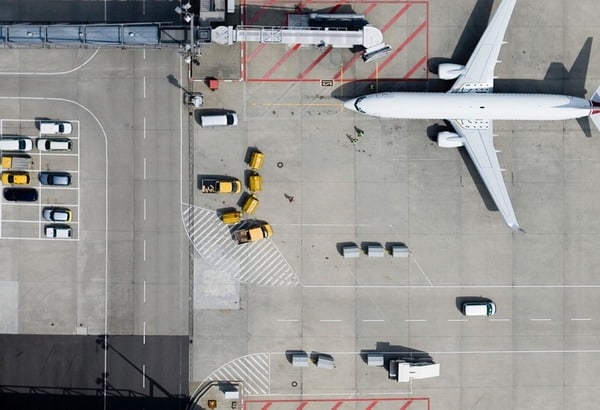
Automation will also allow more efficient use of available resources. A wide range of objects – from baggage or air tugs – will operate using 5G networks, providing huge amounts of data in real time.
The airport will adapt to the needs of passengers
In addition, according to SITA representatives, a quick trip to the airport and unhindered passage through all stages of the check on its territory will make some previously profitable services, such as parking, unclaimed. Thus, airports need to find new ways to increase comfort. A personalized approach can help. It will provide passengers with the desired service at any time at each stage of the trip, and not only at the airport.
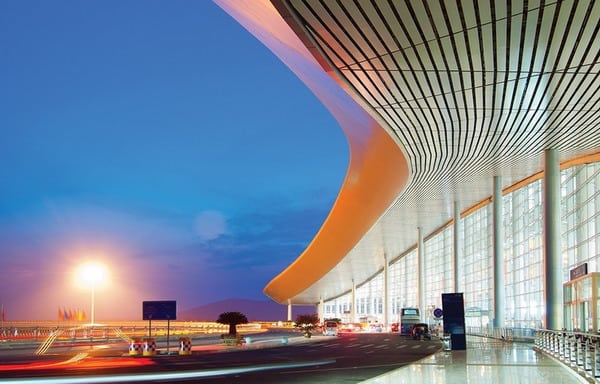
An example is the limousine reservation service provided at the airport, which also includes baggage check-in at your home, office or hotel, plus simplification of border control procedures for regular travelers.
Mobility will be a service on demand
Airports will become gigantic intercepting parking centers, providing access to a wide range of vehicles. By 2030, innovations such as air taxis will appear that will provide a much more efficient transfer to and from the airport.
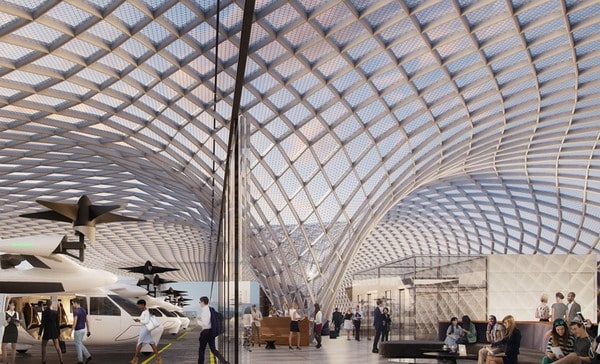
Unified API
Since potential travelers will be digital natives, the people who manage the airports should be equal to them. This technologically competent environment will allow us to divide a complex airport system into a number of information services that can be used as application programming interfaces ( APIs ). In turn, this will provide an ecosystem in which all processes will be carried out much easier thanks to well-coordinated work and innovation, SITA is convinced. For example, thanks to the “new syntax” and artificial intelligence, using the voice service, it will be possible to find out whether, for example, there is a pink suitcase at the exit of B34, as well as to provide transport for those exits where necessary.
Hot Trends for Airport Technology
Biometric Passenger Identification
One of the most sought-after technologies of the future at airports is biometric identification of passengers. It can be used at different stages: for example, for registering passengers on a selfie flight, when passing through border control, at the boarding gate. The implementation of the concept of “face as a passport” can accelerate these processes and increase the throughput of airports.
According to a study by the SITA airline industry developer of IT solutions, released in September 2018, in the next three years, 77% of airports and 71% of airlines plan to invest in large projects or research projects in the field of biometric identification.
Technologies implementing the idea of “a passenger’s face as a passport” have been developed and are fully ready for use. They are safe and reliable. Now the question is to integrate these solutions and put their use on stream at airports, ”says Sergio Colella, President of SITA in Europe.
The countries that have already advanced most in the use of passenger biometrics include the United States, where the regulatory framework allows you to try the most advanced innovations. In the summer of 2017, for example, Jet Blue airline, together with Logan International Airport in Boston, began testing a biometric system for identifying passengers at the boarding gate, freeing them from having to submit documents.
The project was launched in collaboration with the developer of this system – SITA, and the US Customs and Border Guard. In September of the same year, the project was recognized as successful and partners announced plans for its development.
As of September 2018, the U.S. Customs and Border Guard is testing biometrics for boarding at 15 major airports in the country. The agency is interested in applying these technologies not only for departing, but also arriving passengers. For the latter, biometrics is tested at 14 US airports.
The introduction of biometric identification of passengers is gradually going on in Europe. In Italy, for example, 3 airports – in Rome, Bologna and Naples introduced biometric passport control.
In Russia, with its rather conservative regulatory framework, airports are only taking the first steps to use the biometric identification of passengers. Moreover, such technologies are already widely used at Russian airports to control internal security. The plans to integrate facial recognition software-based technology VisionLabs by trained neural networks in the business halls work at Moscow ‘s Domodedovo airport informed the airline the S7 Airlines. The company expects that it will help identify S7 Airlines passengers and personalize services for visitors to business halls.
Artificial Intelligence
By the technological trends can be attributed to the AI (Artificial Intelligence, AI). According to SITA, 61% of airports will develop AI projects in the next three years. In 2017, the share of such was 34%. In this case, we are talking about the application of these technologies for predictive analytics in order to improve the operational performance of the airport.
With the help of artificial intelligence, it is possible to improve the predictability of processes at the airport, understanding what is happening in it at a particular moment and what can happen later. It is possible to predict with great accuracy the consequences of a given incident for the airport, including strikes by employees that often occur in a number of countries, to predict the consequences of a delay in a flight and to warn passengers in advance, gave examples of TAdviser by Sergio Colella of SITA.
Robots
Robotics is also one of the technologies that are beginning to be widely used at the airport. For example, they can take passengers’ luggage right at the airport entrance. Such a robot developed by SITA is being tested, for example, by the airport in Geneva. It allows the passenger to independently scan their boarding passes, put the bags in the cargo compartment of the robot and attach tags printed by the robot on them. After that, the robot closes its cargo compartment, so that no one could damage the luggage on the way to the loading station, where people will transfer luggage to the conveyor belt.
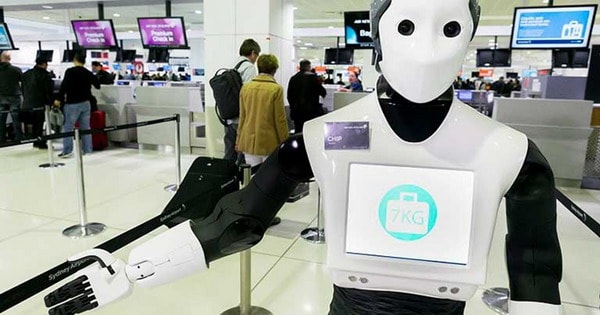
According to SITA Sergio Colell, a large airport may need about 50 such robots to have a significant effect.
In the summer of 2018, the Dutch airline KLM Royal Dutch announced plans to launch Care-E assistant robots at the airports of San Francisco and New York. They can take luggage from passengers and escort them to the desired point in the airport building.
In the summer of 2018, a robotic terminal opened at the Singapore airport. Automated check-in desks and luggage belts, passport control with face recognition technologies are available to passengers. At the airport, innovative baggage scanners are also installed that do not require laptops and phones to be carried out of hand luggage. Robots at this airport also work as cleaners.
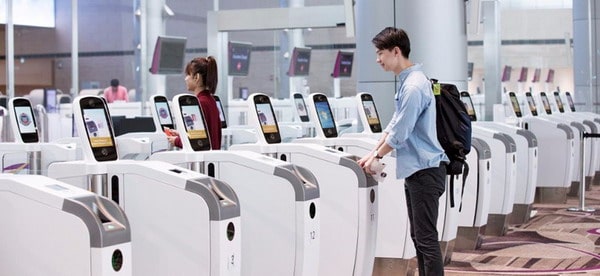
In addition to passenger service, robots are also used as law enforcement officers, acting as police officers. Such robots, for example, can be seen at the airport at La Guardia Airport in New York.
Robotic equipment is also used at Russian airports. So, for example, in September 2018, at the Moscow Domodedovo Airport, testing of a robotic warehouse for temporary storage of baggage was completed, which should provide additional safety and accuracy when delivering baggage of passengers on a flight. Two minutes after the arrival of the team, the robots find the desired tray and transport the bag to the flight picking site.
Blockchain
There are interesting prospects for use at airports and blockchain technology. It can be used for a wide range of purposes – from the process of identifying passengers to selling tickets, tracking luggage and managing frequent flyer customer service programs. Each of these usage scenarios can improve the collaboration of all industry stakeholders.
According to a SITA study, by 2021, 34% of airports are planning research projects in the blockchain field. The most desired result of using the blockchain is the simplification of the passenger identification process: representatives of 36% of airports say this.
Airport’s CIOs called tracking the state of property, such as baggage (28%), and operational efficiency (24%) as potential benefits from the blockchain.
A lot of companies take part in flight services, which need to exchange reliable and timely information. To simplify this task, SITA has developed the Flight Chain smart contract system. British Airways and Heathrow, Geneva and Miami Airports are already using it. The objective of the system is to allow airlines and airports to resolve the issue of quality of flight status data. The system stores flight information in the blockchain, providing a single reliable source of data.
Brussels Airport, for example, in the summer of 2018 launched the Freight Management App, a blockchain application designed to track the movement of goods at each stage of delivery – from loading and unloading to freight forwarding. The application works in conjunction with BRUcloud, an open data management platform in which the airport plans to integrate all its operations.
At Brussels Airport, it is hoped that the use of the blockchain will completely digitize logistics information, move away from the manual process of filling out documentation for importing products, and also increase transparency and efficiency.
Baggage Tracking Technologies
In June 2018, Resolution 753 of the International Air Transport Association (IATA) entered into force, requiring the airline to track baggage throughout the route. Baggage losses remain a big problem and bring major losses to air carriers.
One of the most popular ways to fulfill the conditions of the new resolution, which is being adopted by airports, is to supply all passengers with RFID tags. In SITA, for example, they see this technology as the most promising for the above purpose. Despite the fact that we are talking about airline obligations, the RFID technology for baggage can also be attributed to those used at airports: it is there that baggage tracking starts and starts.
At the beginning of 2018, at U.S. airports on domestic flights, and between London Heathrow and the U.S., Delta began using RFID labels to track baggage. In the short term, Delta planned to introduce this technology at 344 airports. The technology allows Delta passengers to track the exact location of their bags through the mobile app in real time.
Hong Kong International Airport has been using baggage tracking technology with RFID tags since 2008. She is also used by Cathay Pacific, Dragon Air and Air China.
In Russia, a pilot project using RFID was launched at Sheremetyevo Airport in 2016, and Aeroflot has planned to use such a service since 2018.
Technology Barriers
The speed of introducing new technologies at airports largely depends on how quickly local legislative and regulatory regulation will change in different countries, allowing for the application of innovations, from airport operators, airlines, which are the driver of new passenger solutions.
According to the SITA study, for example, 39% of airports call the main problem in introducing biometric identification at different stages of pre-flight procedures the need to comply with legal requirements. More than a third of airlines also consider the lack of standards for using such technologies to be one of the main problems in this area.
For example, there is a general regulation on data protection in the European Union, and the organization of the use of biometrics at airports must comply with it. And this is quite difficult to do, because the regulation requires obtaining consent from the passenger to use such data for various processes. And when the passenger’s consent is needed every time, it’s difficult to ensure large-scale implementation. There are questions about how to do this when there are passengers who do not agree with the provision and use of their biometric data, and others, said Rolf Felkel, Senior Vice President of Fraport AG, Managing Airport Frankfurt am Main (FRA), in a conversation with TAdviser. (Rolf Felkel).
The speed of innovation in airports is undoubtedly affected by the price of technology – the high cost of projects often serves as an obstacle to their widespread distribution. This can be attributed, for example, to the implementation of RFID baggage tracking: a one-time tag with an RFID tag was initially higher than a regular tag with a barcode.
At the same time, says Sergio Colella, the final financial effect of the use of technologies often exceeds the investments made in them.


